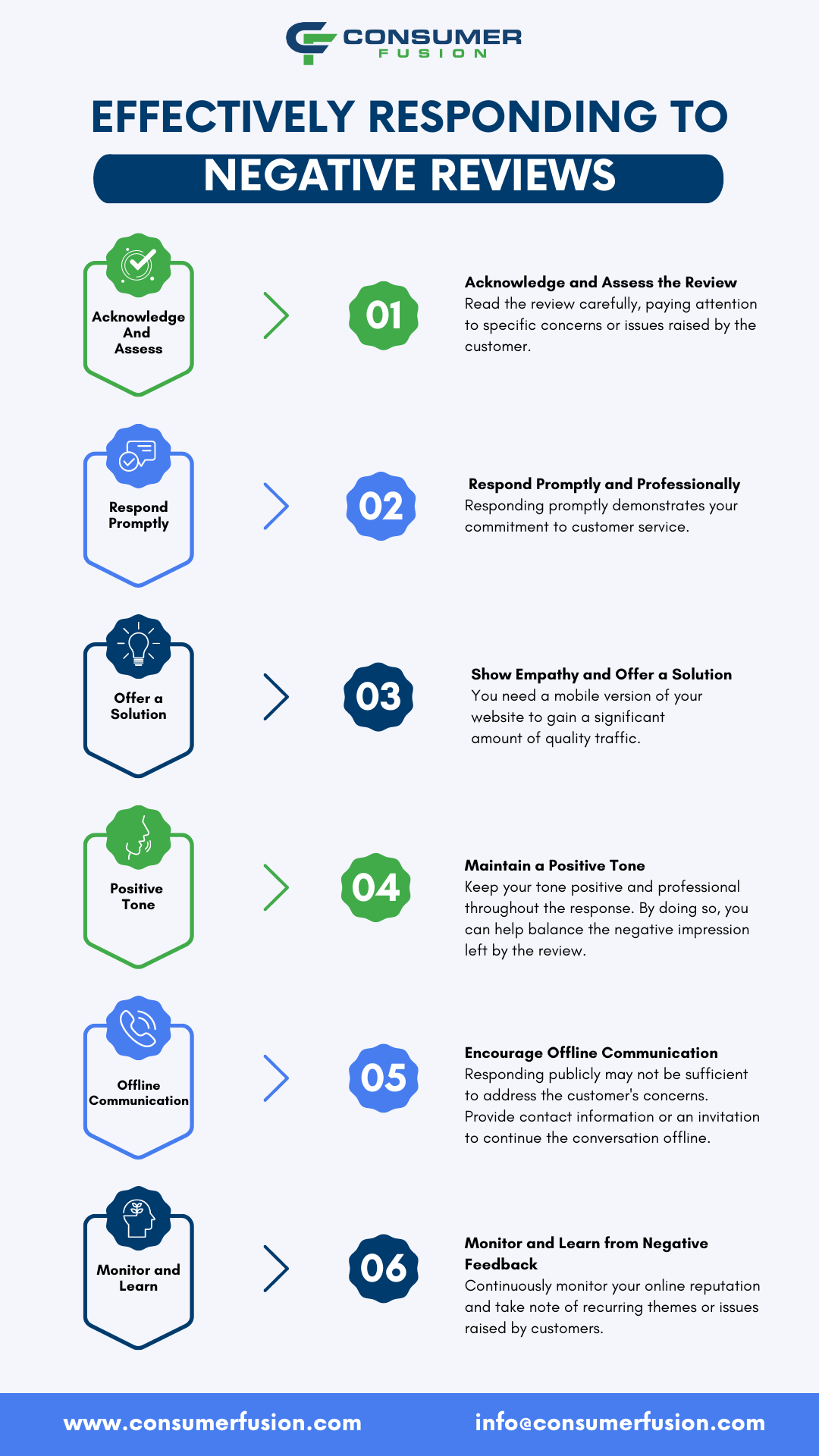Replying to negative reviews, lets talk about it! Your business is online, and with that comes loyal customers and, at times, unhappy ones. In the online world, positive feedback can make your brand soar, and negative reviews can damage your online reputation. But fear not, for negative reviews are not the end of the world. Did you know that 33% of consumers are more likely to change or update their negative reviews if you take the time to respond?
How you respond to these reviews can be an opportunity to showcase your professionalism, empathy, and commitment to customer satisfaction. In this blog, we will explore valuable strategies for effectively replying to negative reviews and managing your online reputation. We will also provide you with effective review responses!
Strategies for effectively replying to negative reviews
1. Acknowledge and Assess the Review
When encountering a negative review, take a moment to step back and assess the situation objectively. Before replying to negative reviews, read the review carefully, paying attention to specific concerns or issues raised by the customer. Understanding their perspective is essential to crafting an appropriate response. Remember, the way you respond can influence not only the dissatisfied customer but also potential customers reading the review.
2. Respond Promptly and Professionally
Time is of the essence when it comes to replying to negative reviews. Responding promptly demonstrates your commitment to customer service. Craft a thoughtful and professional response, addressing the customer by name (if available) and expressing genuine concern for their experience. Avoid using automated or generic responses, as they can come across as insincere.
3. Show Empathy and Offer a Solution
Empathy goes a long way in diffusing a negative situation. Acknowledge the customer’s frustration and express your regret for any inconvenience caused. Take the opportunity to offer a solution or propose steps to rectify the issue. This shows that you are dedicated to resolving problems and improving the customer experience. Invite the customer to continue the conversation privately to address their concerns more thoroughly.

4. Maintain a Positive Tone
While it’s important to acknowledge the negative feedback, replying to negative reviews with defensiveness or aggression will only exacerbate the situation. Keep your tone positive and professional throughout the response. Emphasize your commitment to customer satisfaction and highlight any positive aspects of your business or service. By doing so, you can help balance the negative impression left by the review.
5. Encourage Offline Communication
In some cases, responding publicly may not be sufficient to address the customer’s concerns. Provide contact information or an invitation to continue the conversation offline when replying to negative reviews. By offering a more private channel for communication, you demonstrate your willingness to resolve the issue away from the public eye. This approach shows potential customers that you take customer satisfaction seriously.
6. Monitor and Learn from Negative Feedback
Negative reviews can provide valuable insights into areas where your business can improve. Continuously monitor your online reputation and take note of recurring themes or issues raised by customers. Use this feedback constructively to make necessary changes and enhance your products or services. Demonstrating a commitment to learning and growing can help rebuild trust with your customers.

4. Maintain a Positive Tone
While it’s important to acknowledge the negative feedback, replying to negative reviews with defensiveness or aggression will only exacerbate the situation. Keep your tone positive and professional throughout the response. Emphasize your commitment to customer satisfaction and highlight any positive aspects of your business or service. By doing so, you can help balance the negative impression left by the review.
5. Encourage Offline Communication
In some cases, responding publicly may not be sufficient to address the customer’s concerns. Provide contact information or an invitation to continue the conversation offline when replying to negative reviews. By offering a more private channel for communication, you demonstrate your willingness to resolve the issue away from the public eye. This approach shows potential customers that you take customer satisfaction seriously.
6. Monitor and Learn from Negative Feedback
Negative reviews can provide valuable insights into areas where your business can improve. Continuously monitor your online reputation and take note of recurring themes or issues raised by customers. Use this feedback constructively to make necessary changes and enhance your products or services. Demonstrating a commitment to learning and growing can help rebuild trust with your customers.
Here are a few examples of how you can reply to negative reviews:
Example 1:
[REVIEWER NAME], We want you to know that our team takes all feedback seriously, and we’re truly sorry you did not have a better experience. Please contact us so that we can help resolve any other issues at [EMAIL OR PHONE NUMBER].
Example 2:
[REVIEWER NAME], We’re very sorry you did not have a great experience with our business, and we wanted to apologize on behalf of our entire team. We’d be more than happy to facilitate a resolution if you could please contact us directly at [EMAIL OR PHONE NUMBER].
Example 3:
[REVIEWER NAME], On behalf of our [COMPANAY NAME] team, we want to truly apologize for any frustrations or inconveniences that may have transpired during your experience. We always strive to provide 5-star service, and we’re saddened to hear that we didn’t meet our goal this time. We would like to discuss your experience with our team in more detail. If you could please contact us at [EMAIL OR PHONE NUMBER]. Thank you again for your feedback, and we look forward to hearing from you.
Example 4:
[REVIEWER NAME], thank you for sharing your experience with us. We’re grateful for all feedback, whether positive or negative. We want to apologize for your experience, and we’re so sorry we fell short of your expectations. We’d appreciate the chance to make things right if you could please contact us at [EMAIL OR PHONE NUMBER]. We will do our very best to help rectify this situation!
Remember, these are just examples, and it’s important to tailor your response to each specific situation. Personalize your message, address the customer’s concerns, and showcase your willingness to make things right.
Negative reviews are an inevitable part of doing business and having an online presence. However, by approaching them strategically and with a customer-centric mindset, you can turn a negative experience into an opportunity for growth. Remember to respond promptly, professionally, and empathetically, offering solutions and encouraging offline communication when appropriate. By actively managing your online reputation, you can strengthen customer relationships, build trust, and showcase your dedication to providing exceptional products and services.


















